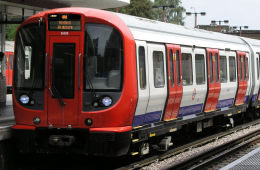Posted 10th October 2012 | 4 Comments
Driverless Underground trains ruled out – for now

New trains have conventional drivers' cabs
DRIVERLESS trains on London Underground will not be introduced in the near future, and some preliminary test runs have been cancelled.
But London Underground may return to the idea in the 2020s, partly because some engineers are claiming that such trains could prove to be safer, although rail unions do not agree. They point out that Underground drivers have played key roles in past incidents, such as guiding passengers to safety when trains have become stalled in tunnels.
New trains now being built for the subsurface lines have conventional drivers' cabs, and London Underground managing director Mike Bown said although LU would continue to explore new technology there were 'no plans' for driverless trains, although a company spokesman said that the idea could be considered again in a decade or so from now.
Some Underground lines, including the Victoria and the Central, are already driven automatically, using a system developed by London Transport in the 1960s, but there is still a driver in the cab who can take full control if necessary.
Trains on the Docklands Light Railway have never had drivers, but each carries a member of staff who is qualified to take over using an emergency control panel.
The RMT had planned a strike ballot in connection with tests of driverless trains. The union's general secretary Bob Crow said: "If the driverless trains plan has been halted that would be a massive victory for the RMT's campaign. But we want to see that in writing along with a guarantee that this nonsense has been stopped for good. Until we get that our battle for both jobs and public safety will continue."
Meanwhile Philippa Oldham, who is head of transport and manufacturing at the Institution of Mechanical Engineers, said that although LU was right to hold back for now, in the end such trains could prove to be safer.
She added: "London Underground drivers do a fantastic job and fortunately accidents due to driver error are very rare.
“But there is a need to raise public confidence in driverless technologies, as in the future these technologies could save lives. Engineers and designers are already developing automated decision-making vehicles, which will be able to achieve an even more reliable, precise and co-ordinated service than humans can."
Reader Comments:
Views expressed in submitted comments are that of the author, and not necessarily shared by Railnews.

James Palma, London
In theory there is nothing wrong with driverless trains. The underground is one of the safest environments for transport. Automtic train protection stops trains as soon as they pass a signal at stop. If the trains had no drivers and there was an accident the driver would not be at risk of injury or death, if there is a 'one under' the driver would not be traumatised, there would theoretically be no delay to services due to staff shortage or disruption due to strike action as other staff could be given the training required. There would likely be no spads or wrong roads. there would even likely be a reduction in people being trapped in the doors as the driver would be in a position to see clearly the full length of the train along with platform staff. The drivers job is not that difficult. Do not be fooled by thinking that during an evacuation the driver does all of the work by himself. it is the station staff that come to assist, the driver stays with the train and follows instructions from control. And to say that they provide essential information...have you used the tube recently? I know, I have driven buses, trams and underground and main line trains.
However, I do believe there is a need for a member of staff on the train. that is essential.
Graham Hughes, Cirencester
This looks like a management climb down to satisfy the unions. It has a bit of a Luddite feel to it. The technology to make trains run with shorter intervals between them relies heavily on automating the processes (as machines are much more reliable than humans in getting the spacings right) and so we are being held up in developing faster tube services by a reliance on human intervention in the process.
I understand that the Crossrail trains will run automatically when in the tunnel under London because that way they can be closed up to make best use of the tunnels? Maybe someone can confirm or refute that.
This technology should not mean a loss of the human in the loop. For all the afety reasons cited there should be an ongoing need for a member of staff to be available on board to assist in the rare event of a problem on the train. That person could sit in the cab. Let's face it, most airline flights are now almost fully automated with a highly trained pilot there to take over and deal with unforeseen problems that demand human intervention. Train driving is, arguably, less hazardous than flying a plane.
Melvyn Windebank, Canvey Island, Essex
Most of these Driverless trains abroad are often no more than a tram line which ruuns back and forth and is not located 100 ft below ground in tunnels over a centry old!!
Philip Russell, Carlisle
I have no idea weather the concept of driverless tube trains would ultimatley prove workable ,but they do operate abroad ,so to simply abandon trials in the face of a bit of union opposition sadly reflects the very short term culture of so much of our railway management these days, Once we led the world in railway development and technology ,but this kind of decision just puts us further down that league.